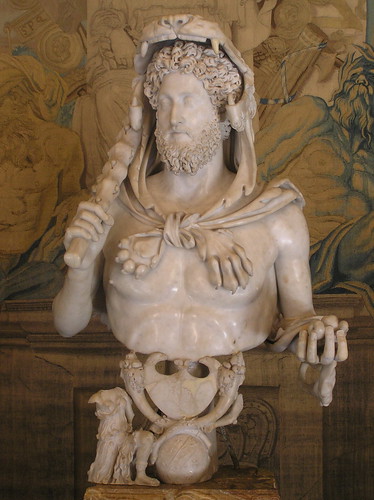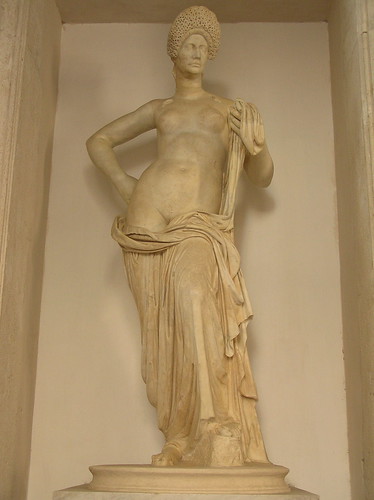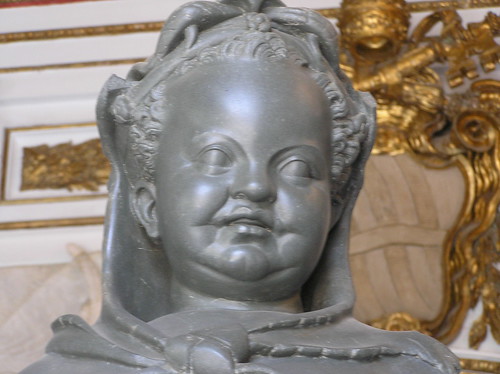herc-u-les! herc-u-les!
We paid a visit to the Capitoline museum (really, museums; there are like two or three) this week, and it got me thinking about bad art. (Maybe I should capitalize that: "Bad Art". Appropriate capitalization makes all the difference between an aesthetic theory and random, incoherent ramblings, no?) The museum is the oldest public museum in the world, and a great place to, among other things, see what a 15th or 18th century idea of a museum looks like.
It's also, of course, a great place to see some Roman and Greek art. In fact, the quantity of quality art gets a little wearisome: I find myself muttering, "oh look, yet ANOTHER masterpiece of ancient art. Whatever, dude." Which is maybe why I found myself thinking, not about good art, but about lousy art.
Because there's plenty of lousy art at the museum, too. There's some stuff that's just bad quality-- sloppy or disappointing-- but not so much of that, and what there is isn't very interesting. What I like is the art that is technically accomplished, that was obviously expensive, and that was designed for a particular market, but that still (to use a technical term) stinks. I think that three examples will suffice to prove that what Tolstoy said about unhappy families is true about unhappy art: every piece is unhappy in its own way.
First off is a statue of the emperor Commodus (reigned late 2nd century, and if you want to know the exact dates, you can Google as well as I can, slacker) as Hercules:

What makes this an example of bad art isn't the technical qualities at all. In the abstract, it's a beautiful piece of sculpture. Whoever made it was clearly a master at knowing how to handle textures: the way that the lion skin is set against Commodus' skin, for instance. This is at a level of excellence that you don't see again until Bernini.
No, this is bad art because of external factors, because I know about what Commodus was all about. The idea of dressing up as a god and expecting to be taken seriously is ridiculous, for starters; and the skill of the sculptor just reinforces that. It just reminds you that this is a guy who fought as a gladiator (you'll be shocked to know that he had a perfect record: who'd have thunk that they might let the emperor win?) and would shoot ostriches with broad-headed arrows and decapitate them. So when I look at the statue- those half-lidded eyes- it's hard not to shudder. Or laugh. Or, um, ludder? shullaugh? Something like that.
Exhibit #2 is a statue of a first-century Roman matron as Venus:

With this statue, I just wonder: what was she thinking? The statue isn't especially good quality (the body is sort of blocky-looking, and doesn't fit together, but it's not awful. What makes it so terrible is the obvious: the inconcinnity between the goddess body and the middle-aged woman head. It's a terrible, terrible car crash of a statue, bringing together the worst of Hellenistic idealized sculpture with the Roman veristic tradition.
It's hard to imagine that it would have looked better to an ancient audience, but there you have it. I'd guess (without any really firm evidence) that it's a semi-mass-produced product, with the body sculpted in advance and the head made to order: the head is a little small, and the neck is a little too long, which makes it seem as if it was done later. But that raises the big questions, which I can't answer: who wanted this thing? Where would it go in the house? Did she think it would fool anybody? What do you say if you're a guest and the proud host shows off her new purchase? I just don't know.
Finally, another example of bad art, which is more like the second than the first. This is a statue of a baby Hercules, found at the baths of Decius, and so probably from the third century:

This is one of the most horrifying pieces of sculpture I've ever seen. First of all, it's a baby, okay? But it's on a strangely elongated body, and it's way bigger than any baby (maybe five feet tall). And the face! The face is bizarre:

It's a mix of stylized elements (the eyebrows, the blank, blank eyes, the mouth with that sort of archaic smile) and veristic ones (the exaggerated chubbiness of the cheeks, the curly hair). It looks alien. But again, this is a quality production. It's made out of Egyptian green basalt: expensive stuff, unusual for Roman sculpture, and, as far as I know, hard to work with.
As with Commodus, it's technically excellent but deeply disturbing. How do you explain it? Again, what's the market for this thing? Is it camp? Did the Romans have a concept of camp? Can you have camp when something is as expensive as this? I truly don't know the answer; all I know is that this is a terrible mix of elements. It's as if you broke into a serial killer's house in the middle of the night, and crept up the creaky stairs, fearing for your life. Then you turn the corner, and in front of you, there's a painting of a crying clown. On black velvet. That's what this statue reminds me of. And I shudder when I see it. (But that's part of the charm, too...)
It's also, of course, a great place to see some Roman and Greek art. In fact, the quantity of quality art gets a little wearisome: I find myself muttering, "oh look, yet ANOTHER masterpiece of ancient art. Whatever, dude." Which is maybe why I found myself thinking, not about good art, but about lousy art.
Because there's plenty of lousy art at the museum, too. There's some stuff that's just bad quality-- sloppy or disappointing-- but not so much of that, and what there is isn't very interesting. What I like is the art that is technically accomplished, that was obviously expensive, and that was designed for a particular market, but that still (to use a technical term) stinks. I think that three examples will suffice to prove that what Tolstoy said about unhappy families is true about unhappy art: every piece is unhappy in its own way.
First off is a statue of the emperor Commodus (reigned late 2nd century, and if you want to know the exact dates, you can Google as well as I can, slacker) as Hercules:

What makes this an example of bad art isn't the technical qualities at all. In the abstract, it's a beautiful piece of sculpture. Whoever made it was clearly a master at knowing how to handle textures: the way that the lion skin is set against Commodus' skin, for instance. This is at a level of excellence that you don't see again until Bernini.
No, this is bad art because of external factors, because I know about what Commodus was all about. The idea of dressing up as a god and expecting to be taken seriously is ridiculous, for starters; and the skill of the sculptor just reinforces that. It just reminds you that this is a guy who fought as a gladiator (you'll be shocked to know that he had a perfect record: who'd have thunk that they might let the emperor win?) and would shoot ostriches with broad-headed arrows and decapitate them. So when I look at the statue- those half-lidded eyes- it's hard not to shudder. Or laugh. Or, um, ludder? shullaugh? Something like that.
Exhibit #2 is a statue of a first-century Roman matron as Venus:

With this statue, I just wonder: what was she thinking? The statue isn't especially good quality (the body is sort of blocky-looking, and doesn't fit together, but it's not awful. What makes it so terrible is the obvious: the inconcinnity between the goddess body and the middle-aged woman head. It's a terrible, terrible car crash of a statue, bringing together the worst of Hellenistic idealized sculpture with the Roman veristic tradition.
It's hard to imagine that it would have looked better to an ancient audience, but there you have it. I'd guess (without any really firm evidence) that it's a semi-mass-produced product, with the body sculpted in advance and the head made to order: the head is a little small, and the neck is a little too long, which makes it seem as if it was done later. But that raises the big questions, which I can't answer: who wanted this thing? Where would it go in the house? Did she think it would fool anybody? What do you say if you're a guest and the proud host shows off her new purchase? I just don't know.
Finally, another example of bad art, which is more like the second than the first. This is a statue of a baby Hercules, found at the baths of Decius, and so probably from the third century:

This is one of the most horrifying pieces of sculpture I've ever seen. First of all, it's a baby, okay? But it's on a strangely elongated body, and it's way bigger than any baby (maybe five feet tall). And the face! The face is bizarre:

It's a mix of stylized elements (the eyebrows, the blank, blank eyes, the mouth with that sort of archaic smile) and veristic ones (the exaggerated chubbiness of the cheeks, the curly hair). It looks alien. But again, this is a quality production. It's made out of Egyptian green basalt: expensive stuff, unusual for Roman sculpture, and, as far as I know, hard to work with.
As with Commodus, it's technically excellent but deeply disturbing. How do you explain it? Again, what's the market for this thing? Is it camp? Did the Romans have a concept of camp? Can you have camp when something is as expensive as this? I truly don't know the answer; all I know is that this is a terrible mix of elements. It's as if you broke into a serial killer's house in the middle of the night, and crept up the creaky stairs, fearing for your life. Then you turn the corner, and in front of you, there's a painting of a crying clown. On black velvet. That's what this statue reminds me of. And I shudder when I see it. (But that's part of the charm, too...)
3 Comments:
That Roman matron as Venus statue is indeed hideous - why isn't THAT in any of our Roman art handbooks? It reminds me of some old cartoon, where they slowly pan up a really sexy female body, strip-tease music playing, only to reveal a decrepit old one-toothed hag's face (to use p.c. terminology).
By the way, I heard from a reliable source that Baby Hercules sucks ass.
I know the overwhelming feeling of going to the Capitoline museum. I think I went there about 4 times with the Centro and various friends and relatives who visited me, and by the last time - ! And nearly everyone in the Centro freaked out at that Baby Hercules...
Thankyou for mentioning Baby Herculese, he was one of my highlights in Rome. People just walk by and don't seem to notice...I really think he should have a cult following at this point. What I love is how many Herculese there are in Rome, it's funny picturing someone coming up with this "twist" and then deciding on the features. You can see how the concept of "baby" and "hercules" slowly in the compromise state made such a warped thing. And - how did they pitch the idea? Whose idea was it??? How did it make it's way to completion? And, the unveiling, how did that go in the 3rd C??? Did people act like we would now and pretend it was cool? It better have been cool, it was so damn expensive. I don't know if you noticed but in the same museum later on there is this extremely drunk/trollopish maiden looking blankly and in a possessed state at the ceiling. The peice is entitled "Truth" - I'm pretty sure there was no irony involved...
Post a Comment
<< Home